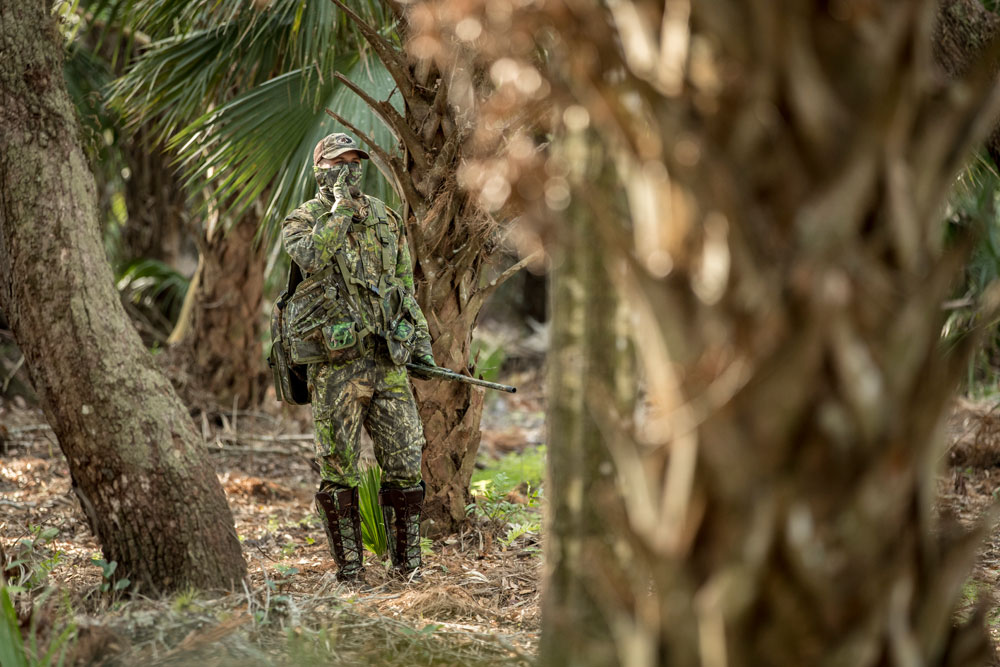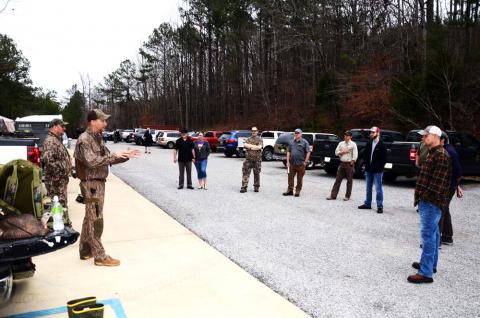provided by John Phillips
As you evolve as a turkey hunter, you will develop a style of calling that you feel most comfortable using, and that you feel gives you the best chance of taking a turkey. Some turkey hunters will hear a turkey gobble, move within 100-200 yards of the turkey, depending on terrain and the amount of foliage they can hide behind, sit down and call for as long as is required to get that gobbler to come to them. Other hunters will move fairly quickly through the woods, calling frequently, until they get a turkey to gobble aggressively. Then they’ll move rapidly to that turkey to try and take him. Other hunters will use different styles of blinds to help break-up their silhouettes and allow them to move without the turkey seeing them.
Mossy Oak Pros Chris Westen and T. R. Pate have two different styles of turkey hunting they each have been successful with and that fit their personalities and styles. You can learn from these Mossy Oak Pros and consider what style of turkey hunting you want to use.
“We took a lot of turkey-hunting equipment to show the students at the Adult Mentored Hunting Program for turkeys,” Westen said. “If you try and carry everything we show you and teach you how to use, you’ll look like a pack mule going on a month-long journey. You’ll be so weighted down that turkey hunting will cease to be fun. I know this because I’ve been there and done that. Today, I travel as light as I possibly can because I cover a lot of ground and that seems to work best for me.

Run and Gun Equipment – Travel Light with Chris Westen:
“When I get ready for turkey hunting, I put on my Mossy Oak headnet, gloves and a camouflage shirt and pants. I also wear a turkey vest. I don’t use decoys – usually because I like to keep my vest light. I’ll also carry a few calls with me, some water and maybe a sandwich. I like the style of turkey calling that’s known as ‘running and gunning.’ I do a lot of running and cover a plenty of ground until I hear a turkey calling. Then I go into my stealth mode and decide what I need to do and where I need to go to put myself in a position to take a turkey.”
Sit and Wait Equipment according to T. R. Pate:
“I carry more stuff than Chris takes with him, especially if I have my little boy hunting with me. I take a turkey blind with me and set it up. I have learned that young children can’t sit still or quiet for very long. When we’re not hearing or seeing any turkeys, my little boy probably will go to sleep. But he can move around in the blind without the turkey or any other critter seeing him move. When I‘ve got a turkey coming in, I can wake him up, and he can see the turkey and possibly even see me take the turkey. If you’re hunting with another person or taking a young or a new hunter with you, or you’re one of those people who can’t or doesn’t want to sit still for a very long time, a turkey blind is the best piece of equipment to keep you hidden, enable you to move without being seen and still allow you to enjoy the hunt. Some turkey blinds are big, and some of them can seat three or four people and hold a camera.
“If you’re hunting by yourself, you may want to use a smaller turkey blind that’s only about 18-inches tall. That blind can fit in the turkey toter in the back of my turkey vest, and I can set it up quickly, pick it up and move it quickly. You’ll be shocked at how much movement you can get away with in a small blind without a turkey seeing you - even if he’s really close to you. If you’re having trouble with some turkeys in a field, and you can’t seem to get close to them or call them very well, you can set up a ground blind where you’ve seen those turkeys go into or out of the field. You don’t have to be particularly good at calling to take a turkey out of a ground blind.
“The real secret to taking turkeys is to be where the turkeys want to be and stay there until they get to where you are, much like deer hunting. Too, turkeys don’t pay attention to a ground blind like deer do. You probably can set up a turkey blind in a parking lot, and a gobbler will walk within 5 feet of that blind and not be spooked. One of the big advantages of using that blind is you can use your calls, like a pot, a slate, a glass, an aluminum or a box call – that all require movement - and not being seen.”






























